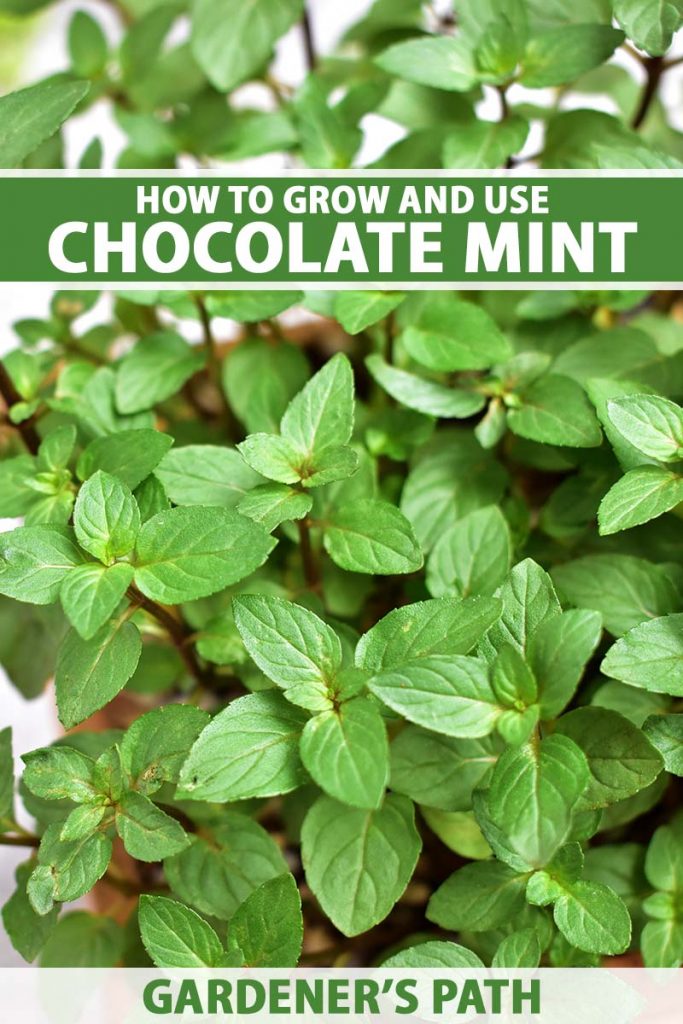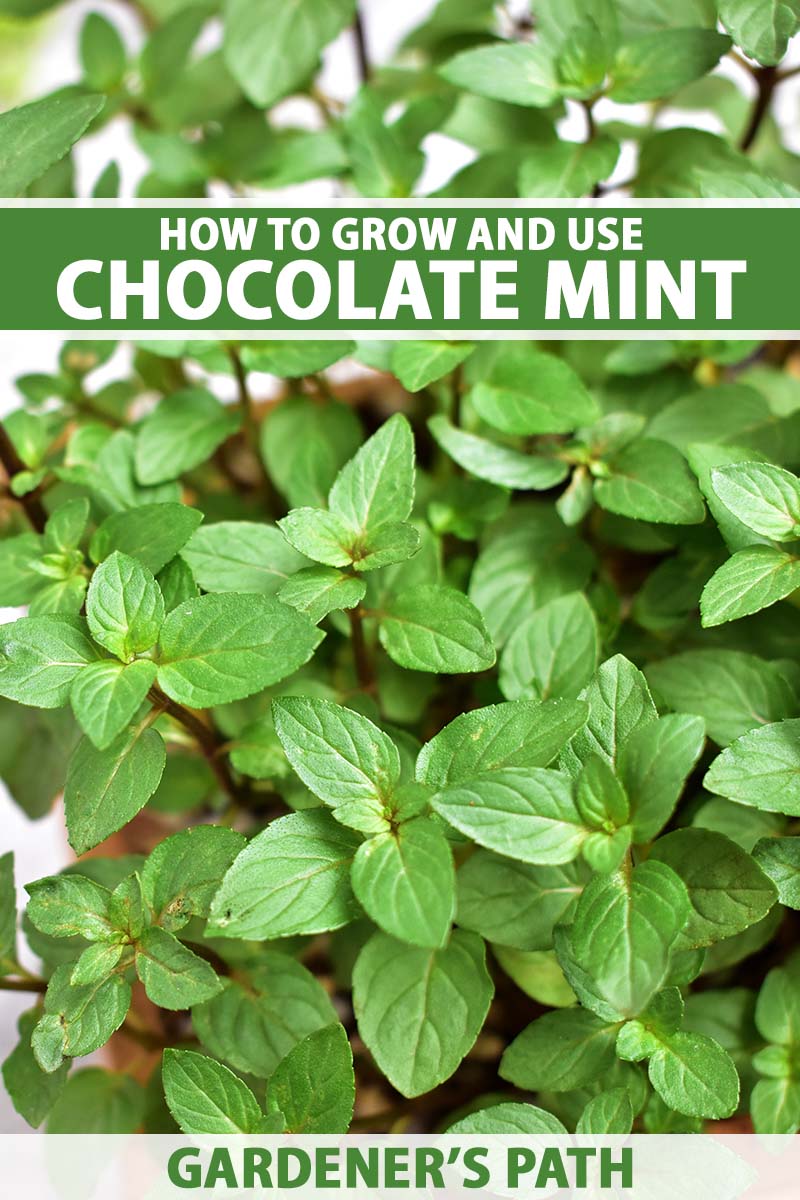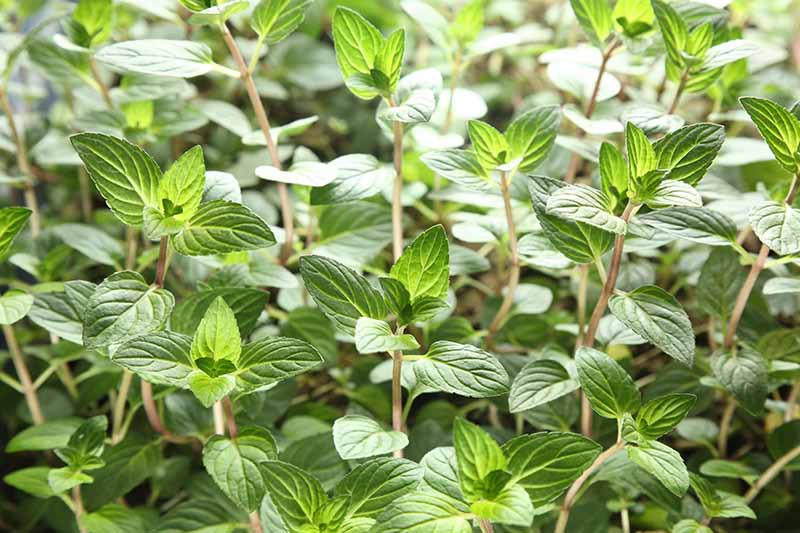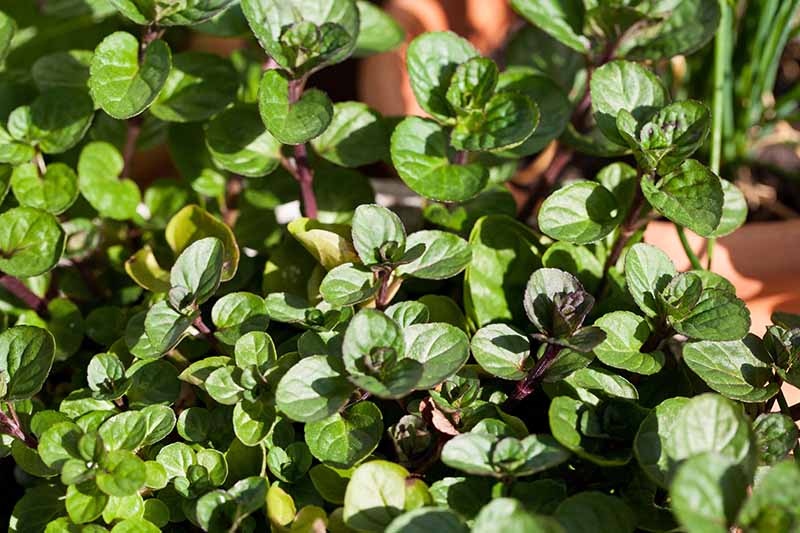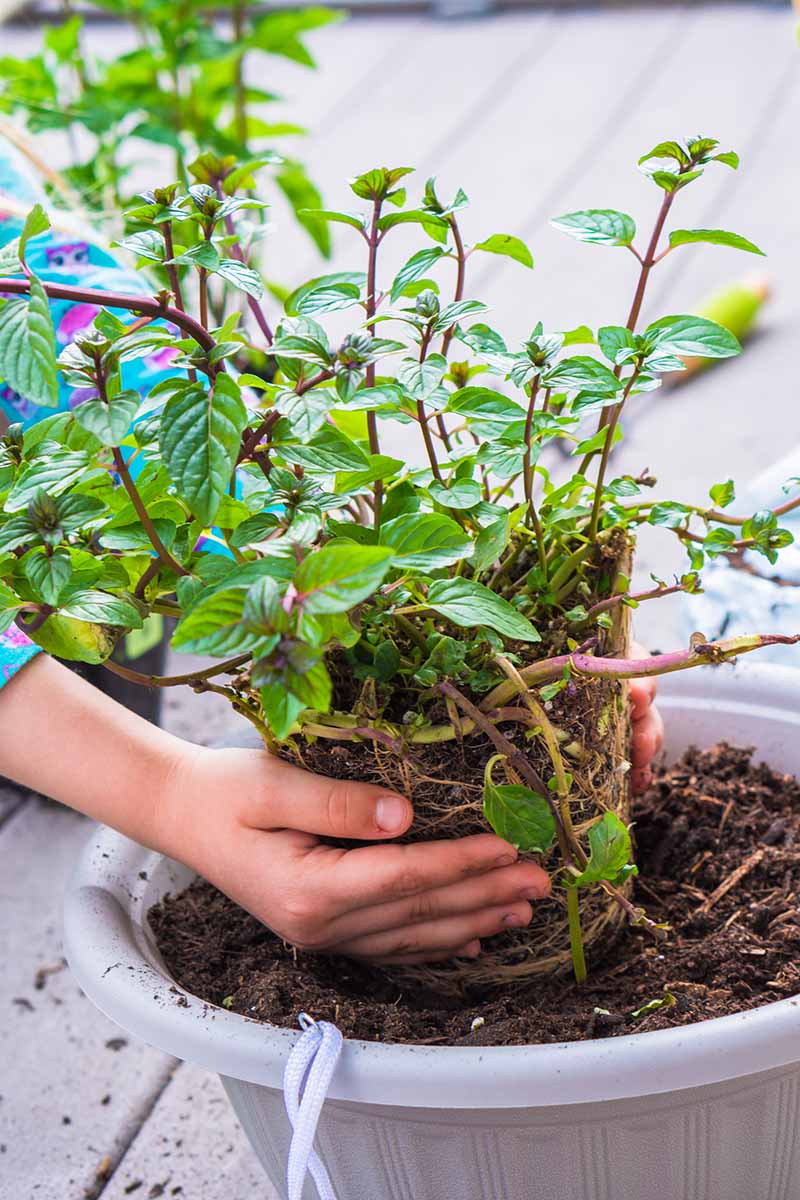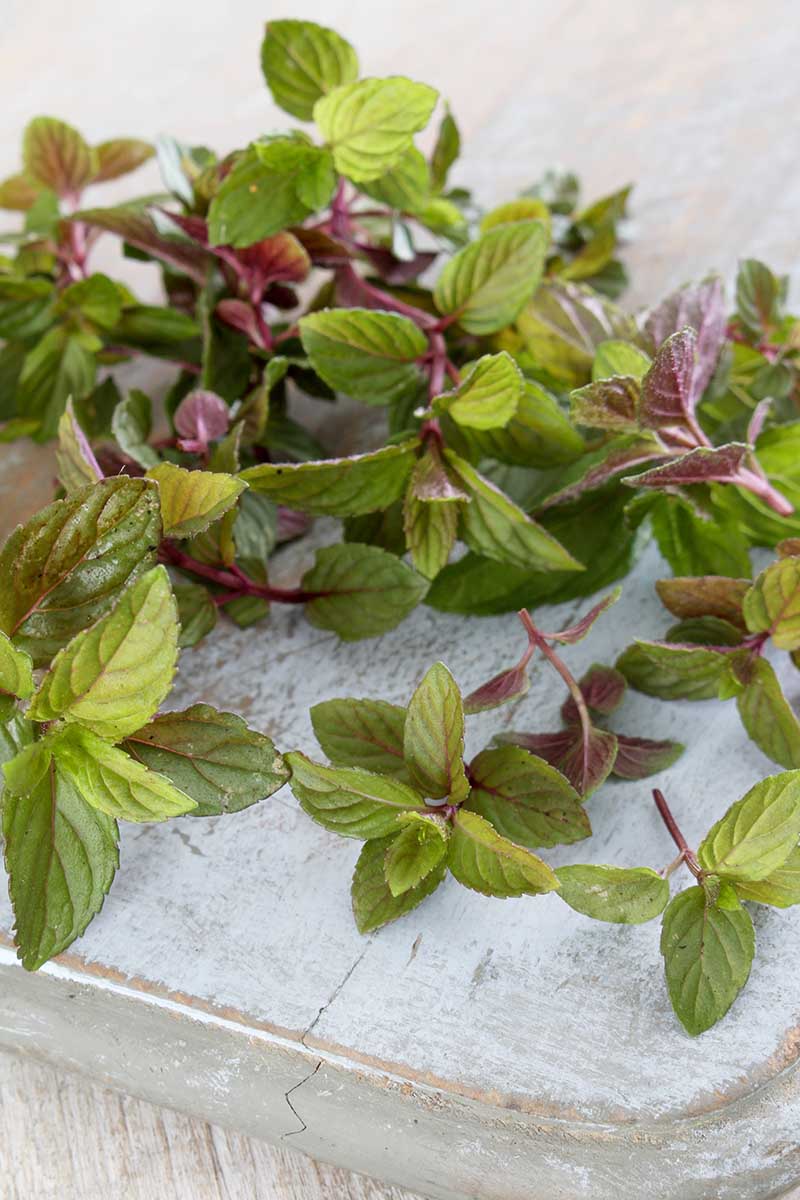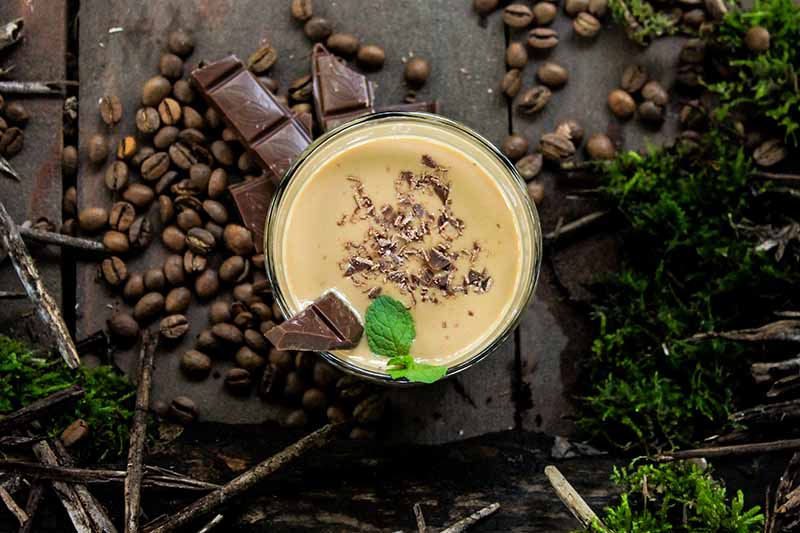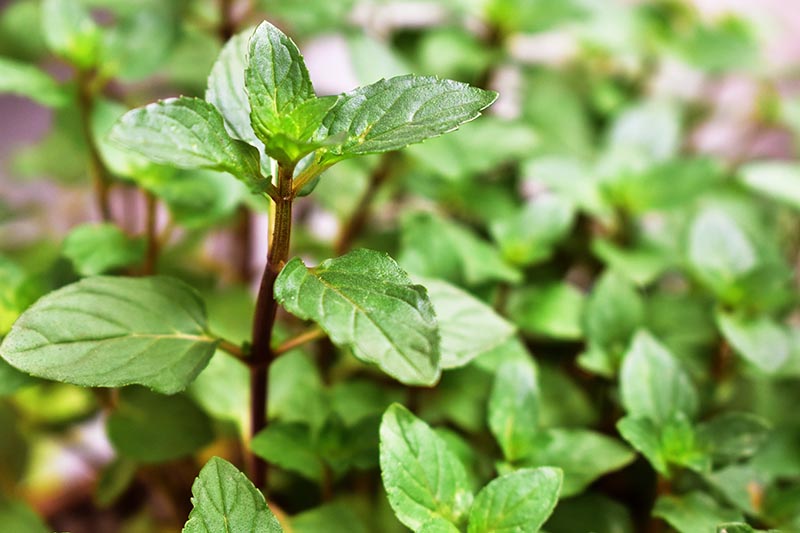We link to vendors to help you find relevant products. If you buy from one of our links, we may earn a commission. The first time I heard about chocolate mint (the plant) was in the grocery store. I’m not going to lie, I was eavesdropping on a conversation between two ladies in the checkout line. Who could blame me? One started talking about her garden, so I tuned in. The other interrupted, saying she’d harvested her chocolate mint the other day and she gushed, none too quietly, “It smells soooo good!” I found my own plant at a nursery not long after that, and I was thrilled to find it really did smell like the inside of a Nestle After Eight wrapper! Ever since then, this variety has been a staple in my kitchen herb garden. People are divided on whether it actually smells like chocolate. Some say it’s all in the mind, and some say it really does have an essence of the rich sweet we so adore. There’s only one way to form an opinion on whether it’s got that hint of chocolate or not… learn how to grow it below, and then find plant of your own!
Cultivation and History
As its Latin name Mentha × piperita f. citrata ‘Chocolate’ suggests, this plant is a cultivar of peppermint, which was selected from a cross between watermint, M. aquatica, and M. spicata, or spearmint.
The result was a sterile hybrid we all know and love: M. piperita! The form citrata, also known as orange mint, was selected for further development. ‘Chocolate’ was one of the resulting cultivars. Its cool peppermint scent, layered with that warm, salivation-inducing, sweet undertone won over the breeders and gardeners. This cultivar has a dark look compared to the bright leaves of peppermint. It grows deep green leaves with purple undersides and dark stems, and is hardy in Zones 3-9. The small lavender flowers attract all sorts of bees and butterflies, and the occasional appreciative human.
Propagation
As a sterile hybrid, peppermint and its cultivars cannot be propagated by seed. Good to know, and I say this from experience because in the past I’ve purchased my fair share of “peppermint” seeds only to be disappointed with the smell and taste of the resulting plant. Luckily, these plants are easily propagated by cuttings, runners, layering, or plant division. For detailed instructions on each of these methods, check out our article on how to grow and care for peppermint.
How to Grow
Chocolate mint is a fast growing, easy plant to have in the garden. Like all plants though, it has its preferences. It grows best with at least five to six hours of sun a day, preferably up to 14 if it’s available. More sun results in the best taste and color.
But this plant isn’t fond of excessive heat, so some shade during the day in the summer can be beneficial. In general, Mentha plants prefer moist soil and will tolerate an acidic to alkaline pH. Enrich sandy or chalky soil with compost to provide a fertile home for your plants. Although they generally don’t need much fertilizer, you can add a layer of compost around the plant annually. Chocolate mint is low maintenance, except in the water department. These are thirsty plants, and will wilt if the soil dries out. I learned how thirsty one of mine was the hard way, before I managed to transplant it in the garden. On a hot sunny day, it wilted in my windowsill, but luckily a good soaking brought it back within a couple hours! Lesson learned: if you are growing this moisture-loving plant, keep an eye on the soil moisture level and water regularly. Check the soil moisture by pressing your finger into the soil surface. If the soil is cool and your finger comes up moist, watering is unnecessary. But if there is no moisture on your finger, water thoroughly. Soggy soil is not ideal for any plant, but mint will tolerate short-term wetness. If you are growing yours in a container, make sure it has drainage holes.
You can grow it in containers or in the garden, but remember – it will spread and take over if left to its own devices. This plant has two growth phases: the first is in the spring when the plant grows upright stems that will produce flowers. The second is post-flowering, when it starts spreading horizontally via runners and rhizome offshoots. If you want your chocolate mint to grow in your herb garden without taking over, try sinking a bottomless bucket into the ground and place your transplant inside to contain it. Learn more about how to grow mint in our guide.
Growing Tips
Grow in full sun for best taste and color Keep soil moist Grow in a pot to contain spread
Where to Buy
Since you can’t propagate hybrid cultivars via seed, if your gardener friends don’t have one for you to take cuttings from, keep an eye out at your local nursery for a potted plant instead.
Chocolate Mint Or you can order potted plants online from Home Depot.
Managing Pests and Disease
Herbivores don’t care for mint, and although this plant doesn’t have many serious pests for you to worry about, it can serve as host to some hungry insects and diseases. As it is a cultivar of peppermint, the insects and diseases that affect chocolate mint are very similar to those of peppermint. Be sure to check out the section in our peppermint article for in-depth information on each of the most common insects and diseases, whether caterpillars, spider mites, mint rust, or powdery mildew.
Harvesting
Begin harvesting individual leaves, stems, or bundles of stems when the plant is four to five inches tall. How much you can safely harvest at one time depends on the size of the plant. Never harvest more than two thirds of the plant at once.
Cutting back the stems in bunches will help keep the plant under control, and encourage bushier growth. The minty flavor is at its peak just before blooming and early in the morning, but it will maintain its distinctive smell and taste throughout the growing season.
Preserving
Leaves are great used fresh, but I’ve found they will retain most of their scent and flavor after they’ve been dried, infused, or frozen for later use too! Fresh cut sections may be stored in the fridge for about four days. You can dry bundles that you’ve harvested by hanging them upside down in a dry, warm place away from direct sunlight. Freeze the leaves by laying them out on a cookie sheet, popping it in the freezer until the leaves are crisp and frozen, putting them in sealed bags, and keeping the bags in the freezer. Or you can freeze them in ice cubes to add to drinks later. Preserve the essence of the flavor by soaking the leaves in oil, whether almond, coconut, or olive, to infuse with the minty, chocolatey smell. Crush fresh or dried leaves and pack into a jar. Fill the jar with oil and set in a warm place such as in a sunny windowsill for at least five days. Strain the leaves and use this in recipes or even as a massage oil.
Recipes and Cooking Ideas
The versatility of this plant, and mint in general, is amazing. Use it to make a refreshing hot or cold tea. Add a few crushed dried leaves to your coffee grinds before percolating to add an extra layer of flavor to your brew. In fact, chocolate mint can be used in a variety of hot and cold drinks. Jazz up a hot chocolate with fresh sprigs or dried crushed flakes. Add it to cocktails as a muddled herb or garnish.
Add to milkshakes and ice cream, and use as a garnish and added flavor note on desserts like brownies, cakes, pudding, and more.
If you’re looking for more healthy ways to enjoy your new herb, you can add it to a variety of salads, including fruit salads. Think about using it in savory dishes too, such as lamb or fish. And since it’s such a fragrant herb, why not add it to potpourri, or use the plant as a natural pesticide against mice, ants, mosquitoes, and more! To find a variety of ideas for using mint that will work for this variety as well, check out these recipes from our sister site, Foodal. I love the smell of this herb, and how easy it was to add to my planting barrel. My honey bees and small wild sweat bees love taking sips from the tiny flowers.
Every time I walk by in season, I crush a leaf to sniff, and salivate over. Do you have chocolate mint growing in your garden? Do you think it actually smells like chocolate, or do you agree with the people that believe it’s all in the mind? Let me know in the comments section below! The mint family contains a large variety of pretty plants, and many fragrant, popular herbs. Check out all these amazing plants and learn how to grow, care for, and use them, starting with these guides next:
How to Grow and Care for Spearmint Plants How to Grow and Use Lemon Balm How to Grow Bee Balm: Bring Out the Hummingbirds!
© Ask the Experts, LLC. ALL RIGHTS RESERVED. See our TOS for more details. Product photo via Home Depot. Uncredited photos: Shutterstock. With additional writing and editing by Allison Sidhu.
